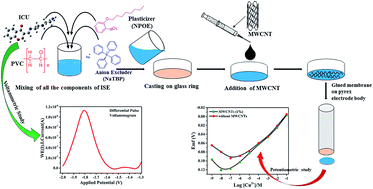MWCNT incorporated imine–amine ionophore for electrochemical sensing of copper ions†
Abstract
A novel potentiometric and voltammetric sensor based on an ionophore (E)-3-(((2-((2 aminoethyl)amino)ethyl)imino)methyl)-4H-chromen-4-one (ICU) has been developed for the detection of Cu(II). The influence of variables including the amount of ionophore, plasticizers, anion excluder sodium tetraphenylborate (NaTPB) and multiwalled carbon nanotubes (MWCNTs) on the performance of the potentiometric sensor was studied. Under optimized conditions, the sensor has a wide linear range of concentration (1.0 × 10−7–1.0 × 10−1 mol L−1) and a low detection limit of 1.0 × 10−7 mol L−1 for Cu(II) ions with a stable response in a working pH range of 4.0–7.0. This electrode was also used as an indicator electrode in the potentiometric titration of Cu(II) ions with EDTA. ICU is a promising molecule with potential as a voltammetric sensor for Cu(II) species in DMSO medium in a concentration range of 2.5 × 10−6 mol L−1 to 4.3 × 10−4 mol L−1 and with a low detection limit of 9.3 × 10−9 mol L−1. Scanning electron microscopy combined with energy dispersive X-ray spectra was used to confirm the interaction between Cu(II) ions and the ionophore on the surface of the electrode. The proposed ionophore is highly selective for Cu(II) ions over a number of metal ions. It was successfully applied for the determination of Cu(II) ions in different real life samples from daily use items. Theoretical calculations also support the complexation behavior of Cu(II) with ICU.


 Please wait while we load your content...
Please wait while we load your content...